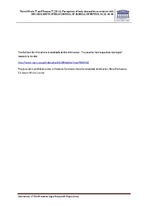| dc.contributor.author | Matoti-Mvalo, Tandi | |
| dc.contributor.author | Puoane, Thandi | |
| dc.date.accessioned | 2011-10-27T13:20:45Z | |
| dc.date.available | 2011-10-27T13:20:45Z | |
| dc.date.issued | 2011 | |
| dc.identifier.citation | Matoti-Mvalo, T. and Puoane, T. (2011). Perceptions of body size and its association with HIV/AIDS. South African Journal of Clinical Nutrition, 24(1): 40-45 | en_US |
| dc.identifier.uri | http://hdl.handle.net/10566/271 | |
| dc.description.abstract | OBJECTIVE: To explore the perception among black South African women that people who are thin are infected with HIV or have AIDS.
SETTING: Khayelitsha, an urban township in Cape Town.
SUBJECTS: 513 women aged 18-65 years.
METHODS: This was an exploratory study employing both quantitative and qualitative research methodology. Data were collected in two
phases. The first phase involved collecting quantitative data among 513 participants. During the second phase, qualitative data were collected
in a purposely selected sub-sample of 20 women. For the qualitative data collection, participants were shown eight body figures, ranging from
thin to obese, and asked to choose a figure representing the ideal figure, a preferred figure and a figure thought to symbolise health. They were
also invited to choose a figure that they thought represented a person infected with HIV or who had AIDS. They had the option of saying that
they did not associate any of the figures with people infected with HIV or who had AIDS. Weight and height measurements were also taken.
After the quantitative analysis was completed, focus group discussions explored perceptions about body image and the relation to HIV among
purposely selected participants. Data were summarised by content based on questions discussed.
RESULTS: Sixty-nine per cent of the participants associated a thin figure with a person infected with HIV, or who had AIDS. Only 10.2% thought
the thin figure symbolised health. Fifty per cent preferred a normal-weight figure, while 34.2% thought that normal weight symbolised health.
Only 2% thought that people in the normal-weight category were infected with HIV or had AIDS.Thirty-four per cent preferred to be overweight
and 31% thought that being overweight symbolised health. None of the participants thought the overweight figure represented people infected
with HIV or who had AIDS. Only 8% preferred the obese figure. The results of the qualitative data analysis suggested that participants preferred
to be overweight and at risk of acquiring cardiovascular diseases, rather than being thin and stigmatised as a person infected with HIV or who
had AIDS.
CONCLUSION: This study revealed that the stigma associated with HIV and AIDS may undermine strategies for prevention of chronic noncommunicable
diseases among urban black South African women. | en_US |
| dc.description.sponsorship | National Research Foundation (NRF) and the Medical Research Council, Tygerberg, South
Africa | en_US |
| dc.language.iso | en | en_US |
| dc.publisher | MedPharm Publications | en_US |
| dc.rights | Copyright held by the Journal. This work is licensed under a Creative Commons Attribution-Noncommercial-No Derivative Works 2.5 South Africa License | |
| dc.subject | Body size | en_US |
| dc.subject | HIV | en_US |
| dc.subject | AIDS | en_US |
| dc.subject | Women | en_US |
| dc.subject | Obesity | en_US |
| dc.subject | Underweight | en_US |
| dc.subject | Cardiovascular disease | en_US |
| dc.title | Perceptions of body size and its association with HIV/AIDS | en_US |
| dc.type | Article | en_US |
| dc.privacy.showsubmitter | true | |
| dc.status.ispeerreviewed | true | |

